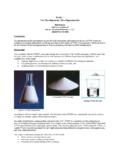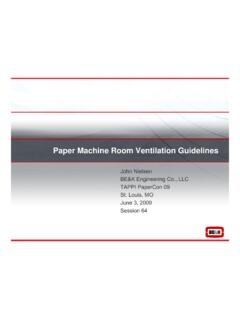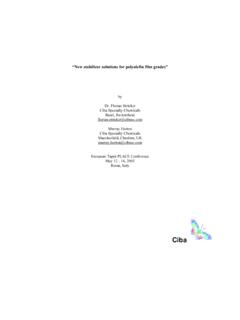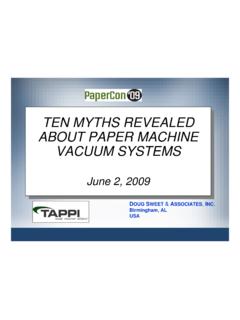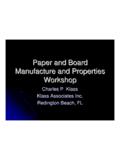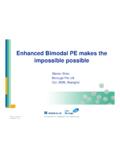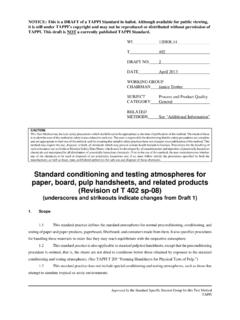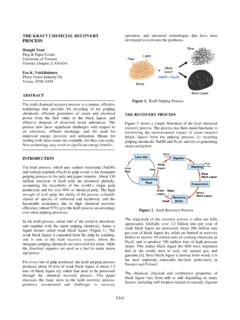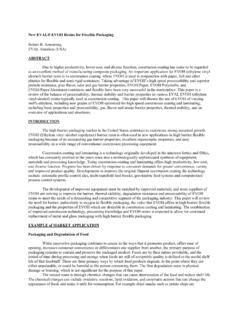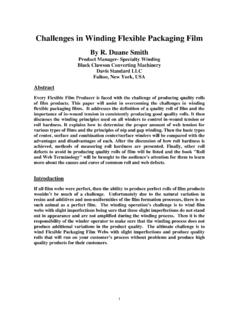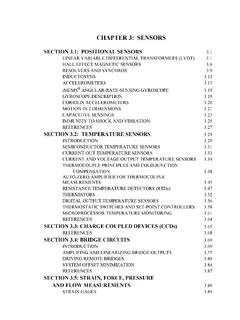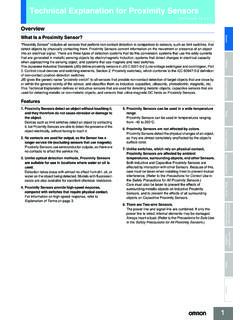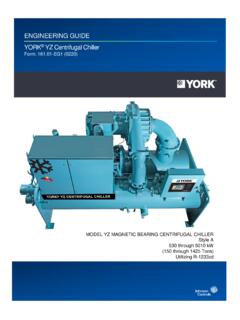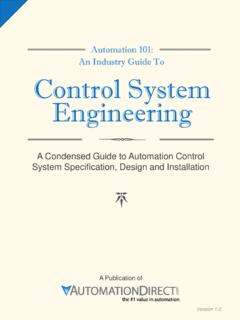Transcription of Brownstock Washing Fundamentals and Practices Table of ...
1 Brownstock Washing Fundamentals and Practices Table of Contents i. Preface ii. Contributing Chapter Authors Introduction Washing as a Fractionation Process Early Washing Systems Modern Washing Systems Reasons for Washing Why Vacuum Drum Washers are so Important Layout of the Current Book References Fundamental Factors and the Different Types of Washing Physical Factors Impacting Washing Stock Type Stock pH. Temperature Air Entrainment Operational Factors Impacting Washing Inlet Consistency Discharge Consistency Drum Speed Pulp Mat Consistency and Filtration Pressure (Pressure Washers). Wash Water Entering Velocity through the Pulp Mat Dilution Factor Fundamental principles Drainage Diffusion Mechanical Compression Sorption Types of Washing Dilution Extraction Displacement Diffusion Acknowledgement References Fundamental Design of Vacuum Washing Systems Approach Flow Elements Blow Tanks Low-density dilution zone Process startups Process shutdowns Straight-sided blow tanks Defibrilizers Homogenization Tank Hot-Stock Refiners Deknotting and Screening Understanding the Wash Cycle Main Wash Line Components Filtrate Tanks Baffles Interface ratio Seal pots Vacuum breaker
2 Water seal Soap and Foam Handling Soap skimming from the first-stage filtrate tank Continuous foam handling Foam lines Foam breakers Vacuum Drum Construction and Operation Approach flow feed piping Inlet box Cylinder design Droplegs Valve timing Countercurrent shower flow Nozzles and weir showers Air doctor takeoff Intermediate submerged repulpers Washer hoods References Washing Efficiency Calculations Specific Loading Dilution Factor (DF). Wash Ratio (WR). Displacement Ratio (DR). Thickening Factor (TF). Overall Washing Efficiency Equivalent Displacement Ratio (EDR). Solids Reduction Ratio The Norden Efficiency Factor Modified Norden Number Converting Between EDR and Modified Norden (E10) Number Process Implications Inlet Vat Consistency Drum Speed on Vacuum Washers Equipment Type Considerations References Modern Washing Processes In-Digester Washing Diffusion Washing Atmospheric Diffusion Washers Pressurized Diffusion Washers Horizontal Belt Washers Rotary Pressurized Drum Washers Compaction Baffle (CB) Washer (Filter).
3 Displacement Drum (DD Washer). Extraction Presses Twin-Roll Presses Screw Presses References Wash Water Quality Sources of Wash Water Difficulties associated with specific water sources Modification of wash water to enhance performance (CO2 and pH. modification). Condensates Used in Washing Stripping (cleaning) of foul condensates for reuse as Brownstock wash water Types of Strippers Air Strippers Steam Strippers Integrating BOD-type steam strippers into evaporator systems Anaerobic Treatment of Condensates Condensate Impact on Washing References Impact of Extended and Oxygen Delignification upon Brownstock Washing Extended Delignification Oxygen Delignification Chemistry Process Reaction Conditions Alkali Charge Temperature Retention Time Oxygen Charge Consistency Carryover (raw) and carryback (oxidized)
4 Solids impact on oxygen delignification Delignification Viscosity Post-Oxygen Washing References Trace Metals in Brownstock Washing principles Regarding Calcium in Kraft Cooking and Washing Causticizing and White Liquor Causticizing Clarification and Filtration White Liquor and Wood Chips Heat Impacts Calcium Solubility in Digesters Technical Analysis Catechol Influence Pyrogallol Influence Chelation Supersaturation Inhibition of Precipitate Growth Digester Scale Scale in Brownstock Washing Conclusions References Process Upsets, Troubleshooting, and Optimization Process Upsets Consistency Upsets Temperature Pitch Problems Production Rate Changes Swinging Wood Species between Softwood and Hardwood Blending Pine and Hardwood Black Liquors Mechanical Issues Resulting in Upsets and Long-Term Operating Difficulties Plugging and Breaking Consistency and Flow Meters Valve Stiction Understanding the Basic Washing principles to be Optimized Diffusion Equilibrium Dilution Washing Extraction Washing Displacement Washing Interactions Preparation for Troubleshooting and Optimization Mechanically Sound Operation Operating Procedures
5 Statistical Process Control Charts for Performance Stability Specific Loading and Washer Performance Washing Efficiency Sampling Troubleshooting Treating Symptoms versus Root Cause Analysis Individual Stage and Component Optimization Pulp Mat Profile Inlet Piping Inlet Box Inlet Weir Showers and Displacement Washing Tramp Water Infiltration Wash Water Temperature Entrained Air Drum Vacuum Seal Tanks Process Modeling References Material Balance principles Fundamentals Brownstock Operations Batch Digesters Continuous Digesters Washers Vacuum Washers Wash Presses Diffusers DD Washers Chemi-Washers Digester Washing Oxygen Delignification Screening and Refining Vacuum Washer Thermal Aspects Reconciling Balances with the Real World Characterizing Losses References Pulp Washing Models Introduction General Assumptions Steady-State Models Black-Box Models Split Shower/Decanter Model Nord n's Efficiency Factor Model Perfect Mixing Cells in Series (PMCS)
6 Model Fundamental Models Dispersion Models Mass Transfer Models Statistical Models Wash Press Models Global Steady-State Models of Washer Systems Dynamic Models Model Applications References Pulp Consistency Control Defining and Determining Pulp Consistency Determining Pulp Consistency: Sampling and Laboratory Analysis Choosing a Suitable Sampling Device and Deciding on its Positioning Choosing the Sampler Positioning the Sampling Valve in the Process Accurate Analysis of Consistency Samples Medium-Consistency Considerations in the Pulp Mill Homogeneity Flow Factors Affecting Flow Typical Control Loop The pulp chest and its agitation The Stock Pump Dilution Water Supply Dilution Water Valve Valve Characteristics Water Injection Consistency Transmitter Controller Planning the Consistency Control Loop Typical Dilution Stages Designing the Process to Achieve Correct
7 Consistency at the Dilution Stage Double Dilution Stage Consistency Application Examples Controlling Consistency after a Continuous Digester Transmitter Selection Control Strategy Controlling Consistency after the Blow Tank Transmitter Selection Control Strategy Controlling Consistency after a Medium-Density Tower After the MC Storage Tower Controlling Consistency at a Refiner Reference Instrumentation for Cooking, Refining, Screening, and Washing Flow Meters Magnetic Flow Meter Vortex Flow Meter Differential Pressure Flow Meter Thermal Flow Meter Ultrasonic Flow Meters Sonar Flow Meter Coriolis Mass Flow and Density Meter Turbine Flow Meter Positive Displacement Flow Meter Flow Meter Reference Table Consistency Meters Blade-Type Meters Rotary Meters Optical Meters Microwave Meters Fiber Analyzers Classification (Bauer-McNett).
8 Freeness (Online & Manual). Morphology, Dirt, and Shives Kappa Analyzers Manual and Auto-Titration Laboratory Testing Online Kappa Analyzer Single-Point and Multi-Point Analyzers Temperature Sensors Common Temperature Probes Proper selection and installation of temperature probes Level Sensors Float transmitters Bubbler transmitter Differential pressure transmitter Radar or microwave units Ultrasonic or sonic meters Radio frequency (RF) meters Conductivity Sensors Contacting or Potentiometric Sensors Inductive or Toroidal Sensors Dissolved Lignin Sensors pH Meters Entrained Air Meters Liquor Solids Meters Filtrate Extractors Pressure and Vacuum Gauges Sample Valves References Process Control of Brownstock Washers Process Control Objectives Protection of Personnel, Equipment, and the Environment Variability Reduction Brownstock Washer Example Three Fundamental Components of Single-Loop Control Sensors and Measurements Controllers Final Control Elements (Actuators).
9 Single-Loop Control Dynamics Process Disturbances Control System Disturbances Process Material Disturbances Short-Term versus Long-Term Disturbances Random versus Assignable Cause Disturbances Time-Domain Terms Deadtime Time Constant Gain Gain Expressions in a Single Loop Linear versus Nonlinear Process Gain The PID Loop The Self-Regulating Loop The Non-Self-Regulating (Integrating) Loop Identifying Self-Regulating versus Integrating Loops in the Field Controller Loop Pre-Tuning Considerations Process Modeling Open-Loop versus Closed-Loop Process Steps to Determine Process Gain, Deadtime, and Time Constant Step Test Method 1.
10 Step Test Method 2. Defining Process Needs Common Loop Types Control Loop Block Diagram Tuning Parameter Gains Common Tuning Methods Ziegler-Nichols and Cohen-Coon Lambda Tuning PID Tuning Relationship to Time-Domain Parameters Ideal form of the PID Loop Damping and Filtering Damping Filtering Loop Performance Laplace Transforms and Transfer Functions Control Strategy and Design Considerations Feedback Control (FB). Feedforward Control (FF). PID Control Cascade Control Rati
